February 21, 2014
Air Date: February 21, 2014
FULL SHOW
SEGMENTS
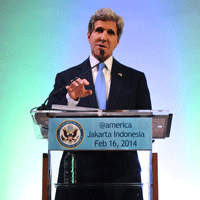
Kerry: Climate is WMD
View the page for this story
Secretary of State John Kerry delivered a fiery speech on climate change on February 16 in Jakarta, Indonesia, calling global warming a weapon of mass destruction. Jennifer Morgan, Director of the World Resources Institute’s Climate Change program tells host Steve Curwood that the speech shows that the United States is taking international climate negotiations more seriously headed into the 2015 UNFCCC climate treaty conference in Paris. (07:40)
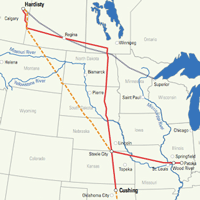
Keystone Ruling
View the page for this story
District judge Stephanie Stacy in Lincoln, Nebraska has struck down the law that gave the state's governor, Dave Heineman, power to approve the route of the Keystone XL pipeline. Her February 19 ruling has been appealed to the Nebraska Court of Appeals, but a final decision on the tar sands pipeline will likely be delayed, perhaps after the US mid-term elections in November . (00:20)
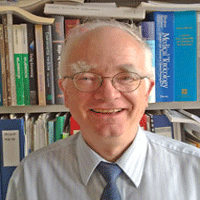
Fluoride and Other Chemical Risks
View the page for this story
New research finds exposure to fluoride in drinking water and several other common chemicals in early life diminishes brain function in children. Study lead author, Philippe Grandjean, tells host Steve Curwood fluoride, flame retardants, pesticides and and fuel additives may be affecting children's intelligence. (06:50)
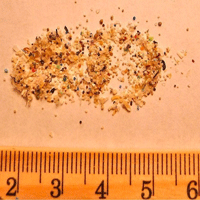
Microbeads in the Great Lakes
/ Kara HolsoppleView the page for this story
Microbeads are tiny plastic spheres found in facial scrubs and other cosmetics, but sewage treatment doesn't remove them from the water, so they end up in lakes and streams. As Kara Holsopple of the Allegheny Front reports, they are a hazard to fish and to anyone who might eat lake-caught fish. (04:50)

Beyond the Headlines
View the page for this story
In this week’s trip beyond the headlines, Daily Climate publisher Peter Dykstra and Living on Earth host Steve Curwood discuss Chevron’s insensitive response to a fracking accident and the Flat Earth Society President’s thoughts on climate change. (05:15)

Saving Monarchs
View the page for this story
At a summit meeting in Mexico February 19, the heads of government of the US, Canada, and Mexico signed an agreement to help Monarch butterfly recovery. Writer Gary Paul Nabhan tells host Steve Curwood that habitat loss in all three nations and and herbicides in the US and Canadian farm belt are blamed for the crash in the monarch's population, and a citizen day of action on April 14 is planned to plant milkweed, which Monarchs need for breeding. (05:50)
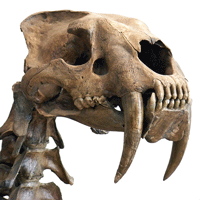
The Sixth Extinction
View the page for this story
Elizabeth Kolbert’s new book, The Sixth Extinction, explores the many ways humans are helping cause the largest extinction event since an asteroid wiped out the dinosaurs. Elizabeth Kolbert discusses what's happening with host Steve Curwood. (13:00)
Show Credits and Funders
Show Transcript
HOST: Steve Curwood
GUEST: Jennifer Morgan, Peter Dykstra, Elizabeth Kolbert, Gary Paul Nabhan
REPORTERS: Kara Holsopple
[THEME]
CURWOOD: From Public Radio International, this is Living on Earth.
[THEME]
CURWOOD: I’m Steve Curwood. Secretary of State John Kerry is on the road lobbying for a strong international climate deal, saying global warming has become an urgent security issue.
KERRY: It doesn't keep us safe if the United States secures its nuclear arsenal while other countries fail to prevent theirs from falling into the hands of terrorists. Climate change can now be considered another weapon of mass destruction, perhaps even the world's most fearsome weapon of mass destruction.
CURWOOD: Also, fluoride, and dry cleaning fluid are among chemicals that interfere with childhood brain development - and could reduce intelligence.
GRANDJEAN: Economists are saying that one IQ point is worth $15,000. This problem is easily $100 billion dollars per year.
CURWOOD: We’ll have those stories and more this week on Living on Earth. Stick around.
ANNOUNCER: Funding for Living on Earth comes from Stonyfield Farm, makers of organic yogurt, smoothies and more.
[NEWSBREAK MUSIC: Boards Of Canada “Zoetrope” from “In A Beautiful Place Out In The Country” (Warp Records 2000)]
Kerry: Climate is WMD
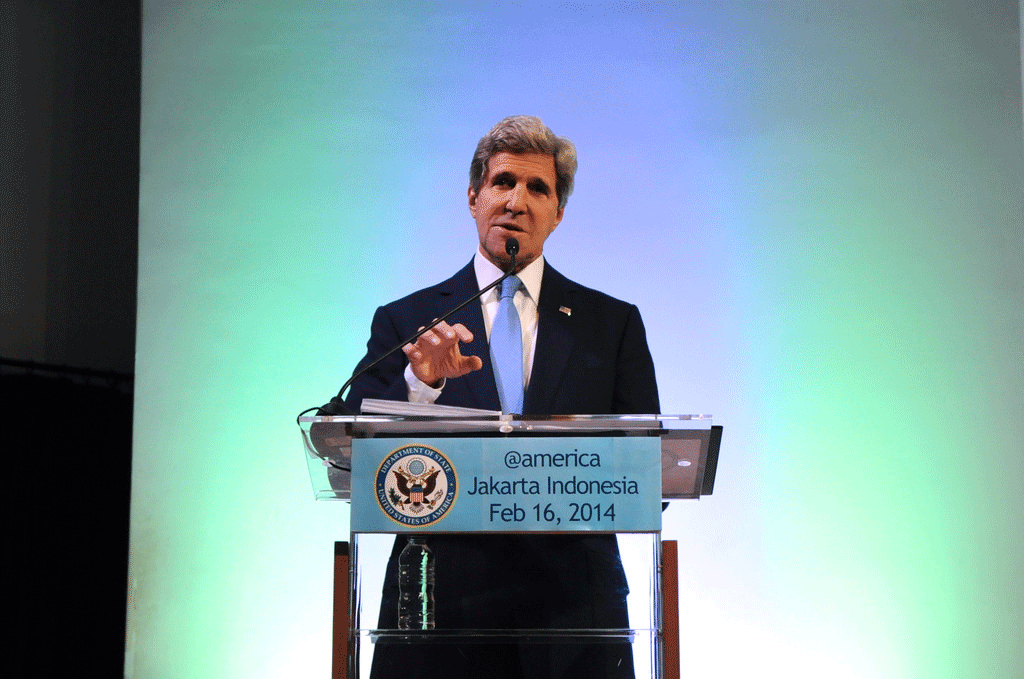
Secretary of State John Kerry delivers his climate change address in Jakarta, Indonesia (photo: US State Department, public domain)
CURWOOD: From the Jennifer and Ted Stanley Studios in Boston this is Living on Earth. I'm Steve Curwood. The Obama Administration is continuing its aggressive drive on climate change. This month President Obama ordered the EPA to develop tough fuel economy rules for trucks, and called on Congress to approve a $1 billion climate resilience fund to help communities adapt to the effects of climate disruption - think droughts and sea level rise. And Secretary of State John Kerry stepped up efforts to get a strong international agreement to reduce global warming emissions during his trip to China and Indonesia. The Chinese, he said, have agreed to collaborate with the US in developing policies for a strong UN treaty to be completed next year in Paris, and the two nations have already settled on a number of key points.
KERRY: Make no mistake, this is real progress. The US and China are the world's two largest economies, we are two of the largest consumers of energy and we are two of the world's largest emitters of global greenhouse gasses. Together we account for roughly 40 percent of the world's emissions.
CURWOOD: But without the rest of the world participating, Secretary Kerry said, a climate treaty would be meaningless. Right after he left China, he went to Jakarta, Indonesia, where he spoke for 45 minutes and used stark language in his call for world action.
KERRY: Think about the proliferation of weapons of mass destruction. It doesn't keep us safe if the United States secures our nuclear arsenal while other countries let theirs fall into the hands of terrorists. We all have to approach this challenge together, which is why altogether we are focused on Iran and its nuclear program, we’re focused on North Korea and its threat. The bottom line is this: it is the same thing with climate change. And in a sense, climate change can now be considered another weapon of mass destruction, perhaps even the world's most fearsome weapon of mass destruction.
CURWOOD: But it's not all disaster, Secretary Kerry remarked. There are also tremendous opportunities in addressing climate change, a potential $6 trillion in new investments to be made and profited from.
KERRY: The solution to climate change is as clear as the problem. The solution is making the right choices on energy policy. It’s as simple as that, and with a few smart choices, we can ensure that clean energy is the most attractive investment in the global energy sector.
CURWOOD: In his speech, Secretary Kerry also promised Indonesia a third of a billion dollars for climate action, and agreed to a "debt for nature" swap to help conserve its tropical forests. To put Secretary Kerry’s trip and speech into context, we turn now to Jennifer Morgan. She’s Director of the Climate and Energy Program at the World Resources Institute and a frequent guest on our show. She says Secretary Kerry probably chose Indonesia as the venue for this major speech because it's central to climate discussions.
MORGAN: Indonesia is tremendously vulnerable to climate change. It’s an archipelago of 17,000 islands. It has a significant agricultural population. If you think about sea level rise, if you think about storms and think of a farming dependent rural economy, they’re highly vulnerable. At the same time, they’re the third largest emitter in the world from their deforestation, and also from their energy emissions. So here you have a country that is very vulnerable, but also a big part of the solution, so I think in some ways it’s a snapshot of all of the challenges and opportunities in one country.
CURWOOD: And I would think that he really wants to get the Indonesians on board the initiative he seems to be pushing now with China as well.
MORGAN: Yes; I mean Indonesia plays a politically important role globally because of their space in the political picture of emerging economies with growing emissions and how you can work together so they can meet their economic goals, but actually be on a positive side on the climate fight.
CURWOOD: In some respects in this speech, Secretary Kerry stepped out further than the President has been willing to go on climate change. I mean the rhetoric of calling climate change a weapon of mass destruction is kind of powerful. It almost reminds me of Vice President Biden speaking out on same-sex marriage before the President did.
MORGAN: Well, I think the Secretary put this in very stark terms and hopefully in a way people can understand. I think there’s a growing understanding and the President is certainly out there on the impacts to the United States, whether it be from the droughts, whether it be from storms, but putting this as a weapon of mass destruction I hope will provide a bigger wake up call for Americans and citizens all around the world of just what’s at stake.
CURWOOD: Now, Secretary Kerry made a strong point of saying the US can’t do this alone, deal with climate; that if everyone in the US carpooled or biked and used renewable power, if the rest of the world didn’t change, we’d still be in a lot of trouble. Why do you think he put that in his speech?
MORGAN: Well, I think there’s this debate internationally about who has to do what, and over history there’s been a very big focus in the Kyoto protocol and other treaties that had industrialized countries like the US lead and take action first. And where the negotiations are right now is trying to look at what every country can do, based on what it’s capable of doing to try and solve the problem. I don’t think, though, he can get away with the fact that the world looks to the US to see what it is doing in order to address its own emissions, and there’s still a huge amount that we can do at home that will both pave the way but also bring opportunity for the United States moving forward. So it is global, but the US is still the number one historic emitter in the world.
CURWOOD: Now, what can Secretary Kerry do in his role as Secretary of State in terms of what happens regarding climate change in this country?
MORGAN: Well, the President and the administration is moving forward on enacting regulations on the power sector and on cars and trucks. But I think what Secretary Kerry can really do is connect these dots. I mean, the United States is vulnerable. We are experiencing these impacts. We need a global agreement to solve the problem, and in order to get the United States to move forward with a global agreement, we need American businesses on board, we need American foreign policy experts on board, we need the public on board, and I think with his passion and his understanding, he can help bring the United States into a global agreement in a way that makes sense, and it’s very clear that it’s in US national interests to do so.
CURWOOD: Now, President Obama has talked about an all-of-the-above energy strategy, but Secretary Kerry emphasized the need for governments to stop subsidizing and developing fossil fuels. Let’s take a listen.
KERRY: Coal and oil are currently cheap ways to power a society, at least in the near term, but I urge governments to measure the full cost of that coal and that oil, measure the impacts of what will happen as we go down the road. You cannot simply factor in the immediate costs of energy needs. You have to factor in the long-term costs of carbon pollution, and they have to factor in the cost of survival, and if they do, then governments will find that the costs of pursuing clean energy now is far cheaper than paying for the consequences of climate change later.
CURWOOD: So, someone listening to that speech might say, on the one hand, Secretary Kerry says we need to transition to clean energy, but then on the other hand, he may well help approve the Keystone XL - that’s a project that would support the development of a particularly dirty source of fuel.
MORGAN: Well, Keystone and approving Keystone would definitely not be consistent with understanding that climate change is similar to a weapon of mass destruction. So I think there needs to be an assessment of how to be consistent across the board and a moment of leadership is coming.
CURWOOD: Which way do you think the Secretary might be leaning on Keystone with such forceful language about climate?
MORGAN: Oh, good question. I think it’s going to be a deep personal dilemma for him, having such a deep understanding of what’s at stake and yet having this big decision in front of him. I hope that he listens to his heart.
CURWOOD: Now in 2015, the global climate negotiations are expected to come up with a major deal, a major agreement to address climate change and I guess a meeting at the end of this year in Peru as part of the preparation for that. How well prepared is the United States to deal with these negotiations at this point?
MORGAN: Well, the US interestingly just last week tabled its version of what it thinks this agreement should look like, and the core elements of that agreement. I think that the US is actually pretty well prepared on thinking through the key issues. I think the additional piece that’s needed is really to be thinking about where the economy needs to go after 2020, which is what this agreement is about. How do we build in a low-carbon economy that has growth in renewables and energy efficiency so that we can send a signal to the world that this is the pathway that the US is going and that they should join in.
CURWOOD: By the way, how important are these upcoming negotiations in your view?
MORGAN: I think these negotiations, they are very important. In some ways, it’s a bit different than it’s been in the past though. You have one key component, which is - every country needs to bring forward their offer of what it will do after 2020 to tackle climate change. And then on top of that, you have a negotiation about what architecture does that get plugged into? How do we build an agreement that can spiral up ambition moving forward? And I think from a multilateral perspective, this is just a fundamental moment and hopefully can be a turning point where the world’s countries can come together and show that they really understand what’s at stake.
CURWOOD: Jennifer Morgan is Director of the Climate and Energy Program at the World Resources Institute. Thanks for joining us, Jennifer.
MORGAN: Thank you.
Related links:
- Watch Kerry's speech here
- Jennifer Morgan, World Resources Institute
- Follow her on Twitter
[CUTAWAY MUSIC: Brad Mehldau: “The Falcon Will Fly Again” from Highway Rider (Nonesuch Records 2010)]
Keystone Ruling
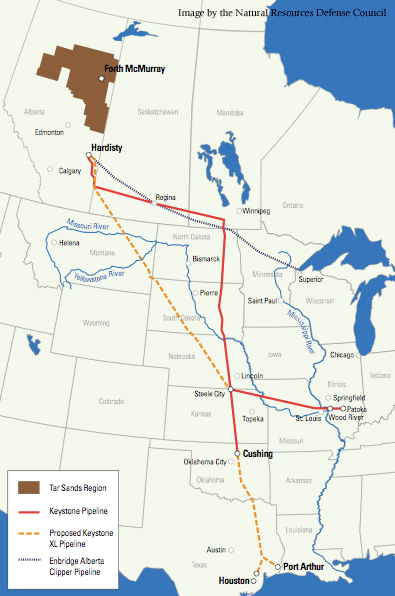
The proposed Keystone Pipeline would carry tar sands oil from Canada, across Nebraska, to refineries in Texas.
CURWOOD: By the way, as regards the approval decision Secretary Kerry is in line to make about Keystone XL, a Nebraska district judge has just struck down the state law that allowed Governor Dave Heineman to approve the pipeline's route. The Governor has appealed the ruling, but the litigation is expected to further delay any final decision - perhaps until after the mid-term elections
Related link:
Bloomberg News Report on the Keystone route ruling
[MUSIC: Michael Bloomfield “Susie’s Shuffle” from From His Head, To His Heart, To His Hands (Columbia Legacy Records 2014)]
CURWOOD: Just ahead...more evidence that tiny plastic microbeads in your facial scrub may not be good for you, or the rivers and lakes where they end up.
MASON: They essentially look like fish eggs. They look like food and so the biggest concern is the possible ingestion of these microplastics by aquatic organisms.
CURWOOD: They're a hazard in the food chain - and to people who might eat the fish. That's coming up. Keep listening to Living on Earth.
[CUTAWAY MUSIC: Brad Mehldau: “The Falcon Will Fly Again” from Highway Rider (Nonesuch Records 2010)]
Fluoride and Other Chemical Risks

Philippe Grandjean is an adjunct professor at the Harvard School of Public Health. (Philippe Grandjean)
CURWOOD: It's Living on Earth, I'm Steve Curwood. Lead. Mercury. Arsenic. PCBs. Toluene. These are common chemicals that researchers know can damage developing brains. Now a new study in the journal Lancet Neurology evaluates earlier research involving six different but also widely used chemicals that seem to affect brain function.
Perhaps most startling, this review raises more questions about fluoride in drinking water, suggesting that despite its dental benefits, fluoride could permanently impair cognitive development in children. The additional chemicals documented as neurotoxins in this article include PERC, which is used as dry cleaning fluid, manganese, used as a gasoline additive, certain fire retardants, and the insecticides Dursban and DDT. Dr. Philippe Grandjean of the Harvard School of Public Health, was the lead author.
GRANDJEAN: We looked at every single industrial chemical that we could find information on, and our conclusion is that we’re now up to 12 industrial chemicals where we have evidence that they can damage the human brain development.
CURWOOD: When you say ‘damage human brain development,’ what do you mean?
GRANDJEAN: Well, what we have seen with these chemicals with that the effects may be cognitive, meaning that they may relate to higher brain functions, they may relate to motor control, they may relate to a behavior. There is evidence that they can also be related to depression, so we’re talking about a range of different aspects of brain function, if a child is exposed to the chemical during early life or if the exposure happens in the mother’s womb, then we can see later on that the child does not have optimal brain functioning.
CURWOOD: In the United States, how many children do you estimate are exposed to these chemicals at meaningful levels?
GRANDJEAN: We’re all exposed to levels that can actually interfere with brain development in humans. Of course, it’s a matter of the dose, how much we are exposed, because we get pesticide residues from the fruits and vegetables unless they’re organic, we get mercury even if we avoid tuna and other large fish, we’re still exposed to a little bit of mercury. And my message is let’s minimize those exposures, we know how to do it. Let’s do the best we can as soon as possible, and then do the systematic testing of industrial chemicals so that we can figure out which additional ones to control.
CURWOOD: You say these chemicals are in general circulation, and that virtually everyone is getting exposed to them at meaningful high levels. How do they relate to what we see in terms of the high number of kids with autism, a lot of discussion about ADHD, Attention Deficit Hyperactivity Disorder?
GRANDJEAN: Well, we have actually not quite convincing evidence in regard to which chemicals contribute to autism and ADHD, but I suspect that the very same chemicals that are causing the dysfunctions and deficits - where we have convincing evidence - I suspect that the very same chemicals can also trigger the disease development in the kids that end up with, for example, autism. But because the etiology of those diseases is complex we haven’t quite been able to extract the convincing evidence yet.
CURWOOD: What do you think exposure to toxic chemicals is costing our society?
GRANDJEAN: Quite clearly, if a child is losing IQ points, then that child will have a lesser chance of completing high school, getting a higher education, etcetera, and landing a well paying job. So economists are saying that one IQ point is worth about $15,000. If you then look at the lead exposures in this country - exposures to lead - that translates to a loss of about $50 billion dollars per year. Mercury is something like $5 billion dollars, pesticides somewhat more. So this problem is easily 100 billion dollars per year.
CURWOOD: Professor, let’s talk about fluoride. Fluoride is something that I think everyone is familiar with. It’s in toothpaste. It’s in a lot of drinking water. What harm, if any, is this perhaps bringing to children?
GRANDJEAN: Fluoride appears to be just like the other chemicals that damage brain development, but most of that evidence comes from China. We looked at more than 20 studies from China where they have compared children exposed to high fluoride content in the water and low. And on the average, the difference in the performance among those kids was seven IQ points. That’s a sizable difference. And obviously some of the kids have been exposed to substantial fluoride concentrations in water, some of them were just a little bit above what’s in this country, therefore I find that evidence very worrysome, and we need to follow up and determine if there is any risk in regard to fluoride exposure under US conditions.
CURWOOD: How do you think your research is going to impact the regulation of industrial chemicals?
GRANDJEAN: I hope that our findings will be recognized in the US Congress because right now the politicians are discussing how to update the vastly outdated chemicals regulation, the Toxic Substances Control Act from 1979. Compared to regulations in the European Union and countries like Japan and Korea, America is way behind in controlling chemicals and regulating the most toxic ones. I think it’s a positive sign that both of the Senate and the House of Representatives are currently discussing how to modernize this legislation.
CURWOOD: Dr. Philippe Grandjean is co-author of the paper in the Lancet Neurology and a Professor Environmental Health at Harvard School of Public Health. Thanks so much, Professor.
GRANDJEAN: My pleasure.
Related link:
The Lancet Neurology
Microbeads in the Great Lakes
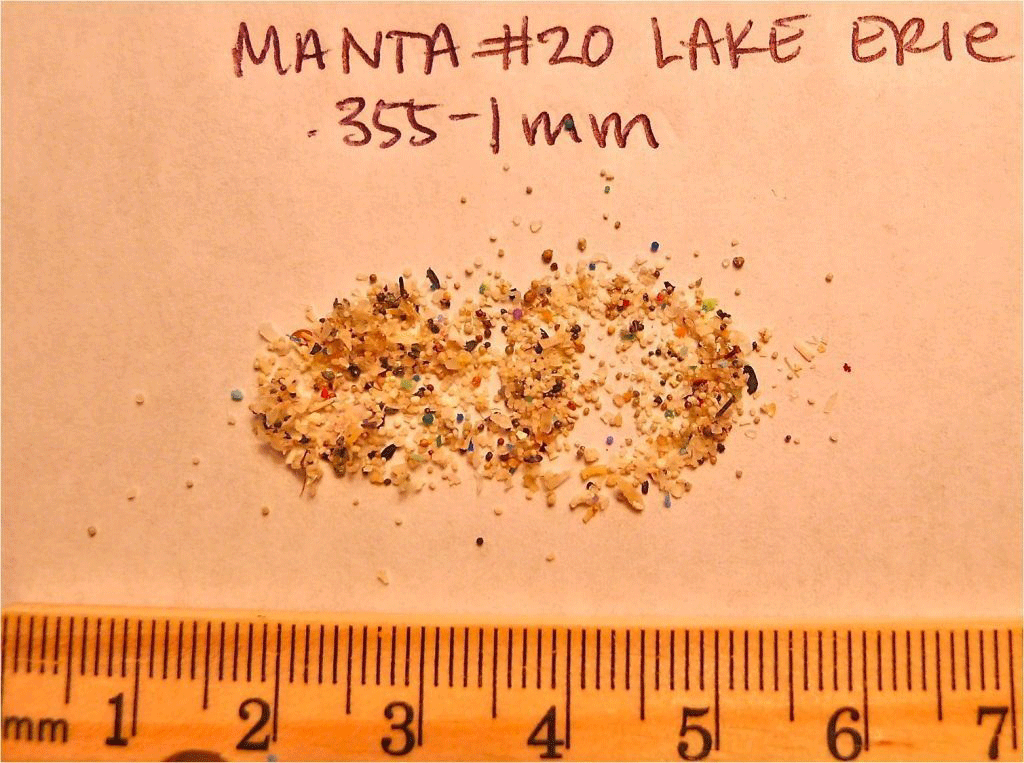
The majority of the plastic that Mason and her team found in the Great Lakes were tiny pieces called microplastics. (photo: 5 Gyres)
CURWOOD: New York State recently introduced legislation to ban another hazard in the environment - a particular form of plastic called microbeads. They’re tiny spheres of plastic that you find in skin care products like facial scrubs and exfoliants, but they’re so small, water treatment plants don't remove them and they end up in rivers and lakes. A recent study - the first of its kind - looked at plastic in the Great Lakes, and how it gets there. Kara Holsopple from the public radio program the Allegheny Front reports.
HOLSOPPLE: Salon owner Marla Degenhart is enjoying a hand massage with a creamy French vanilla scrub.
[SLATHERING SCRUB ON SKIN]
DEGENHART: That’s awesome. [LAUGHS] It feels great. Very scrubby, and it’s also a little more exfoliating than the oatmeal.
HOLSOPPLE: Degenhart makes the homemade scrubs herself for her Lunasea salon and spa in Pittsburgh.
DEGENHART: Everything that I use, every ingredient that I use is biodegradable. I’m very earth-conscious. I’ve been like a hippie my whole life. I don’t look like one, but I think like one. [LAUGHS]
HOLSOPPLE: Degenhart adds oatmeal, fine pumice, and even ground up walnut shells to her exfoliating masks and cleansers.
These natural skin care products are the kind that Dr. Sherri Mason says she’d like to see more of. She’s from the State University of New York at Fredonia. Mason’s been pulling an ingredient in the commercial version of cosmetic scrubs out of the Great Lakes by the thousands - microplastics.
MASON: About 60 percent of the microplastics we found were these perfectly round, spherical balls. And those definitely don’t come from the degradation of larger plastic items.
HOLSOPPLE: They come from face washes and cosmetics with small, colorful plastic beads - microbeads - that do the job of exfoliating skin. Mason and her team have been trawling the Great Lakes by boat for the last two summers, looking for plastic. Their work is the first study of plastics pollution within the Great Lakes, and one of the first on freshwater plastics pollution.
Half of the plastic in oceans are microplastics--pieces about 1 to 5 millimeters. In the Great Lakes, it’s 80 percent - most of it in Lake Erie.
Many of us think of plastic pollution as an eyesore--plastic cups and bottles floating near the beach. But little plastic pieces make their way into the Great Lakes first as those larger plastic items like bags or cups - trash that gets washed through storm drains. Then they get broken down by sun, wind, and water. In the case of microbeads, they come through municipal sewers. Mason says finding that so many of these microplastics were little beads was a surprise. And they could be creating big problems for wildlife.
MASON: They essentially look like fish eggs. They look like food. The biggest concern is the possible ingestion of these microplastics by aquatic organisms.
HOLSOPPLE: Mason says similar ocean studies show they are eaten by birds and fish--they’re so small even mussels and plankton - at the bottom of the food chain - can eat them. The plastics prevent wildlife from digesting real food, and that can kill them. But that’s not the only issue. Mason says the Great Lakes were once a dumping ground, and even though pollution is more regulated now, some chemicals are persistent. Plastics found during Mason’s study had elevated levels of industrial chemicals like PCBs. Michelle Naccarati-Chapkis with Women for a Healthy Environment explains why.
NACCARATI-CHAPKIS: Those dangerous chemicals can essentially bind to plastics.
HOLSOPPLE: Her Pittsburgh-based group’s been reaching out to other environmental groups in the Great Lakes region, asking them to put pressure on retailers to stop carrying products which contain hazardous chemicals. They’re worried about chemicals which can’t be removed through water treatment. Naccarati-Chapkis says it bioaccumulates; the fish eat these toxic-coated plastics and then we eat the fish.
NACCARATI-CHAPKIS: So we know that it works up the food chain and as a result will impact human health as well.
HOLSOPPLE: Naccarati-Chapkis, Sherri Mason and others say that eating fish from the Great Lakes - where commercial fishing is an important industry--could be dangerous because the toxins in the plastics the fish ingest could leach into their flesh that we eat as food.
[MUSIC: Datasette “Micro” from Aviatrix (EchoEcho 2009)]
Beyond the Headlines
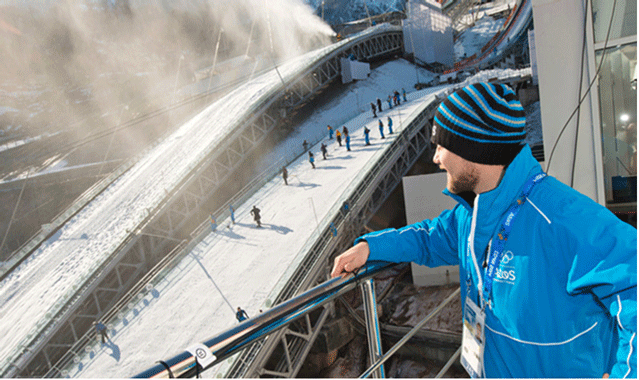
The ski-jumping events at Sochi needed lots of artificial snow. Many of the world’s winter Olympic locations will be too warm to host the games in the future (photo: Atos International, Creative Commons 2.0)
CURWOOD: Let's take a few minutes and a spade now to dig beyond the headlines with Peter Dykstra. He's publisher of DailyClimate.org and Environmental Health News - that's EHN.org. And as usual he’s on the line from Conyers, Georgia. Hi there, Peter, what’s on offer this week?
DYKSTRA: Well, hi, Steve. I’m going to start out with something you’ve already touched on the show. Secretary of State Kerry pretty much threw down the gauntlet, he likened climate change to a weapon of mass destruction, but when he said that the former House Speaker Newt Gingrich had a cow, and he called for John Kerry’s resignation.
CURWOOD: So, wait. Newt Gingrich is pushing back against climate change, but didn’t he do a TV commercial with Democrat Nancy Pelosi a few years back calling for action on climate change?
DYKSTRA: He did indeed, and that would be an interesting climate change debate, to pair up Newt Gingrich from 2014 against Newt Gingrich from 2008 on climate.
Here’s something else Secretary Kerry touched on. He quoted President Obama, who last year compared climate deniers to the “Flat Earth Society.” And you know actually I have a little problem with that, comparing climate deniers to Flat Earthers, because last year, there was a reporter named Alex Seitz-Wald. He’s from Slate.com. He actually tracked down the President of the Flat Earth Society, Daniel Shenton…
CURWOOD: Wait a second here, Peter. There really is a Flat Earth Society?
DYKSTRA: Of course there’s a Flat Earth Society, Steve, what’s the matter with you? Their website says the Flat Earth Society is also accepting new members now, by the way, and yes, they really do think the Earth is flat. But their President, Daniel Shenton, said he accepts the notion that fossil fuel burning is warming the earth.
CURWOOD: So even the Flat Earth Society believes in global warming?
DYKSTRA: Not quite, because President Shenton made it clear that he was speaking for himself, not for the entire Flat Earth membership. But you can say that the leading proponent of Flat Earth Theory has figured out that CO2 warms the planet, whatever shape our planet may actually be.
CURWOOD: And - elsewhere on the globe, if in fact it is a globe?
DYKSTRA: Here’s a story that I think is a little bit surreal. Out in Bobtown, Pennsylvania, north of Pittsburgh, they were preparing a natural gas fracking well last week. The well blew out. It’s a pretty serious story, there’s one Chevron contractor who went missing, another one was injured, and it totally scared the locals out of their wits.
CURWOOD: So, being a very responsible corporation, Chevron must have swung into action to fix the problem and calm local folks, right?
DYKSTRA: Oh, they did, but the most conspicuous gesture from Chevron didn’t go over well. What do you do to tell your neighbors you’re sorry for the ear-splitting explosion and ongoing gas venting?
CURWOOD: Do tell, Peter.
DYKSTRA: You give them free pizza. About a hundred neighbors closest to the blast, they got a letter of apology from Chevron and a coupon for a free pizza from the local pizza joint.
CURWOOD: Is that all?
DYKSTRA: No that’s not all. The coupon was also good for a two-liter bottle of the beverage of their choice.
CURWOOD: I can hear the voiceover of the ads right now: “If our gas well explodes, your pizza is free.”
DYKSTRA: Yeah, pretty much. To be fair to Chevron, they’re donating money as well to local fire departments. They’re doing some other things, but it’s a really strange parable. The fracking phenomenon is growing. There’s a lot of small town jobs and money to be made, there’s a lot more to be made at the Wall Street, the power politics, the total overhaul, for better or worse, of our energy system, but there are also enormous unanswered questions, enormous environmental risks and opposition both nationally and locally in a lot of places.
CURWOOD: Ah, a mere slice of the epic story of fracking.
DYKSTRA: Yeah, thank you. That was cheesy.
CURWOOD: What else do you have for us?
DYKSTRA: Have you been watching your Winter Olympics the past weeks?
CURWOOD: How could I avoid it?
DYKSTRA: Well, it’s been a little un-winterish over in Sochi. They’ve had problems with soft ice and snow, with temperatures in the host city over 60 degrees Fahrenheit a few times. There were a couple of days at the home of the Winter Olympics where it was warmer than places in Florida this past week.
CURWOOD: And with all the planning and building and hype that goes into staging the Olympics, the weather is always a wild card, right?
DYKSTRA: Of course there’s weather around the world, but there’s also global climate, and that’s a little different. The next Winter Olympics are in 2018. They’re supposed to be in South Korea. It’s a fairly cold location based on average temperatures. But after that in 2022, they haven’t picked that site yet. There are five competing places to host the 2022 Winter Games. Our Daily Climate reporter Lindsey Konkel took climate projections for those five places: Beijing, Oslo, also cities in Poland and Kazakhstan, and the Ukraine. And all five of the contestants to host the 2022 Winter Olympics are potentially looking at average temperatures that might make Sochi look absolutely frostbitten.
CURWOOD: Does the slush factor figure into what the Olympic Committee uses to decide where they site games. They look at climate change?
DYKSTRA: Ah, they do. They actually have for the past couple of Olympics, and we’re looking to see how the decision comes out for 2022. That decision is due just about a year from now. Those five choices may all have question marks though.
CURWOOD: Peter Dykstra is publisher of Environmental Health News and the DailyClimate.org. And to get more on these stories you can go to our website - that’s LOE.org. Thanks, Peter.
DYKSTRA: Thanks Steve, talk to you soon!
Related link:
Follow Peter Dykstra on Twitter
[MUSIC: Devo “Gut Feeling/Slap Your Mammy” from Are We Not Men? A: We Are Devo (Warner Bros. 1978)]
CURWOOD: Coming up! Turning to the three amigos to help save the Monarch Butterfly. That's just ahead on Living on Earth. Stay tuned.
[CUTAWAY MUSIC: Jazz Soul Seven: Gypsy Woman” from Impressions Of Curtis Mayfield]
ANNOUNCER: Funding for Living on Earth comes from the Grantham Foundation for the protection of the environment. Supporting strategic communications and collaboration in solving the world’s most pressing environmental problems. The Kendeda Fund, furthering the values that contribute to a healthy planet, and Gilman Ordway for coverage of conservation and environmental change. This is PRI, Public Radio International.
Saving Monarchs

Monarch butterflies are completely dependent on milkweed for their reproduction. (photo: Make Way for Monarchs)
CURWOOD: It's Living on Earth, I'm Steve Curwood. One of the most iconic migrations in North America is that of the eastern Monarch Butterfly, which flies from Mexico through the US to Canada and then back to Mexico over several generations. But this population of Monarchs is in severe decline, even though the logging that destroyed part of its wintering grounds in Mexico has largely been halted.
On February 19th, the heads of government of Mexico, the US and Canada - nicknamed the three amigos - met in a summit session outside Mexico City that included plans to set up a joint Monarch butterfly task force. Writer Gary Paul Nabhan, with the group Make Way for Monarchs says they have an idea what's caused the recent collapse in population numbers.
NABHAN: Well, we now suspect the problem is in the breeding grounds, the summer breeding grounds of Monarch butterflies in the United States and Canada. Now Monarchs have a complex cycle that gets them through their migration both ways. Four or five generations of Monarchs can appear in North America over the warm season, and each of them is exclusively dependent on milkweed plants for laying their eggs and the larvae eating their first meals from those milkweed plants. And eating the milkweeds, they gain a toxin in their bodies that helps repel predators to some extent. We can’t have Monarch butterflies without milkweeds, and by some counts milkweeds have declined to only 59 percent of their former abundance in midwestern corn fields.
CURWOOD: What has happened to milkweed?
NABHAN: Well, milkweeds have been decimated by the untargeted and obsessive use of certain very effective herbicides. Those herbicides are now used in conjunction with herbicide tolerant crops - cotton, corn and soy - and that means that the crops can survive the herbicide spraying but most weeds cannot. Milkweeds themselves are not tolerant of the herbicides called glyphosates, and because of that their numbers have declined more in the last decade than any known period in American history.
CURWOOD: Now as I understand it, your project Make Way for Monarchs has plans to plant lots of milkweed all over America. How would you do that?
NABHAN: That’s right. We’re solutions driven and we rely on both collaborations with governments and nonprofits, but we’re putting out two to three million milkweeds to local garden clubs and native plant societies. So two to three million plants will go out this summer, along highway sides and in the rights of way of electric transmission lines and railroads.
CURWOOD: Now how urgent is this problem? I noticed that a couple years ago we had a lot of Monarchs in our backyard. I counted I think over 20 one evening, but last year I don’t think I saw any. And I live in southern New Hampshire.
NABHAN: Well, what you’ve seen in southern New Hampshire is similar to what’s happening in about a dozen states, Steve. People who have regularly observed or even tagged Monarch butterflies just didn’t see them this last year. And now we have the confirmation from Mexico that this was the worst year in recorded history of reliable counting of the Monarchs that arrived there.
CURWOOD: Gary, can you imagine in our lifetime years with no Monarchs? What are the odds they could go extinct altogether?
NABHAN: Well, the irony is that other once common widespread species have gone extinct in North America. For all purposes, that’s what happened with the chestnuts due to a disease and due to hunting we lost passenger pigeons. And now we’re trying to make sure that does not happen to Monarch butterflies.
CURWOOD: What can the average person listening to us do for Monarchs?
NABHAN: Well, all of us can plant gardens of milkweeds and the wildflowers that Monarchs need for nectar in our own homes, schools and in parks. We can also join together for what will be an April 14 day of action and contemplation for Monarchs on the 50th anniversary on the death of Rachel Carson, the scientist, of course, who wrote Silent Spring and is the matron saint of the environmental protection movement. We’re having church services and public discussions throughout America on April 14 to draw support for protecting both Monarchs and other pollinators and the wild plants that they depend upon to complete their lifecycle.
CURWOOD: How would you feel if this species when extinct in your lifetime?
NABHAN: I would be heartbroken. I think that Monarchs are an icon, a symbol, not just of hope, but of the transformations that people make on their own personal, emotional, and spiritual journey through life. And so Monarchs are significant in ways just beyond their biological reality. They’re of mythic proportions. And that’s why so many children as well as adults are attracted to their story.
CURWOOD: Gary Paul Nabhan is co-facilitator of the nonprofit Make Way for Monarchs based in Patagonia, Arizona, outside of Tucson. Thanks so much for taking the time with us today, Gary.
NABHAN: Thanks, Steve.
Related links:
- Make Way for Monarchs
- Text of joint summit press conference, including remarks about the monarch task force
[MUSIC: Herbie Hancock “Butterfly” from Flood (Sony Records 1975)]
The Sixth Extinction
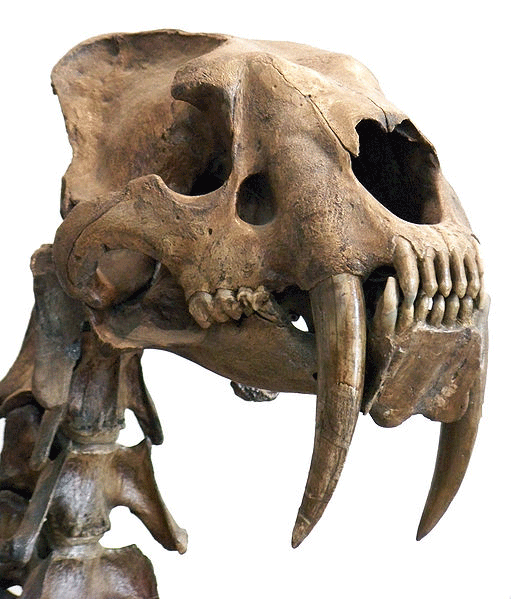
Ths Saber-toothed tiger went extinct at the end of the Pleistocen Epoch, some 11,000 years ago. (photo: Wikimedia Commons)
CURWOOD: To research her book, Field Notes from a Catastrophe, New Yorker writer Elizabeth Kolbert traveled the world to find places where climate change is already having an impact. For her new book, Kolbert again packed her bags, but with a different aim - to see how climate change, and other impacts of the human race are causing the largest mass extinction since an asteroid wiped out the dinosaurs some 65 million years ago. Elizabeth Kolbert says this new book, The Sixth Extinction, An Unnatural History is in many ways a sequel to her previous one.
KOLBERT: I actually went looking for a follow up, another book on climate change to do, because I thought climate change, wow, that’s such a huge story; surely I’ve not exhausted that story yet. And while I was looking around for that, I really came to the realization that climate change is just part of an even bigger story, which are the many ways in which people are changing the planet on a very grand geological scale that will be essentially permanent. We’re changing the world in ways that geologists in the very distant future will still be able to see that something very, very unusual happened at the moment that for us is the present.
CURWOOD: Of course, there’s a lot to talk about, but first let’s talk about a couple of the five extinctions, before this sixth one that humans are driving. It strikes me that these were all somewhat random.
KOLBERT: Yes, I think that’s a very important point to make. The worst of what are called the “big five” of the last half billion years occurred about 250 million years ago. It’s known as the end Permian extinction, and it wiped out something like 90 percent of the species on the planet. And people say, scientists who have studied it say, it came perilously close to wiping out multi-cellular life altogether and sort of pushing the planet back to the state of having only uni-cellular life.
The best hypothesis right now is that it was caused by this massive burst of volcanic activity that took place in what is now Siberia, and formed a formation known as the “Siberian Trap”, which is this huge lava flow that stretches over thousands and thousands of square miles, and that that released a lot of CO2 somehow, it’s not even clear exactly how because it doesn’t follow even from this massive burst of volcanism that that much CO2 would have been emitted, but a lot of CO2 was emitted into the atmosphere, it warmed the planet very radically and it acidified the oceans, it changed the chemistry of the oceans very radically. And one of the very sobering parallels between what we’re doing and what happened at the end of the Permian period is we are also emitting massive amounts of carbon dioxide into the atmosphere and doing it very very quickly.
CURWOOD: Now, talk to be about how you see climate change and the burning of fossil fuels as the driver of extinction for marine creatures.
KOLBERT: In the case of marine creatures, they’re being hit with at least a double whammy. I mean there are many other forces as you know affecting marine life these days. But two big effects of carbon emissions: one is climate change, which is warming oceans very very rapidly just as its warming our land masses but also what happens when you emit CO2 into the atmosphere is a lot of it gets dissolved in the oceans. It gets absorbed by the surface layer of the oceans and it dissolves in the water and when CO2 dissolves in water it forms an acid, carbonic acid. It’s a very weak acid, and you drink it when you drink Coke or club soda. But you pour enough of that into the water and it’s changing the water chemistry.
CURWOOD: Now, you went out with some researchers who are looking at the effects of carbon dissolving in the oceans.
KOLBERT: Yes, I went out with a guy named Jason Hall Spencer who had a really interesting revelation one day when he was taken to go swimming in this spot in the Bay of Naples where there are volcanic vents. So there are these vents at the bottom of the sea that are spewing what turns out to be almost pure carbon dioxide into the water and acidifying the water there - very much in the same way we are acidifying the water - and it occurred to him if he could map what lived in that area, you could sort of look forward in time. And as the chemistry changes, what’s going to happen eventually in life.
And he did this very elaborate census, which required him to spend hours and hours sitting under the water counting every mollusk that was roaming by. You could see that when you were far from the vent, several hundred yards away, you could see there were sea urchins and there were sea cucumbers and there were all sorts of seaweed and then as you got closer and closer to the vents, various things started to drop out, and then when you got right up close to the vents, it was sort of like a lunar landscape. And there were these sort of unfortunate creatures, these mollusks or limpets that had wandered in and their shells were starting to dissolve. You could see that they had these pitted shells, in some cases holes in them because the effect of the water was to actually eat away at their shells.
CURWOOD: And this is like a tenth of a decimal point change in the acidity of the ocean there.
KOLBERT: Well, so far we have affected a tenth of a decimal point change. We’ve already done that and because the PH scale is a logarithmic scale, that represents a 30 percent increase in acidity already, so since the start of the industrial revolution. And if we continue on our present course, by the end of the century we will have affected basically a 0.4 change in the Ph scale, and that represents 150 percent increase in acidity.
CURWOOD: Now we know that the polar regions of the Earth are warming much more quickly that the Equatorial areas, Polar bears are a poster animal for climate disruption, but in your book you note that species in topical areas, including rainforests, are actually at more risk of extinction. Can you explain that?
KOLBERT: Yes, I mean it’s really interesting. As you pointed out the Arctic is warming very very fast, and that’s absolutely true, and if you’re a creature that’s dependent on Arctic sea ice which isn’t going to be there quite possibly in the summer within just a few decades from now, you are quite possibly a creature that’s in a lot of trouble. But the fact is that most organisms live in the tropics, the vast majority of species on Earth live in the tropics, and one of the defining characteristics of species that live in the tropics seems to be that you occupy this very narrow range of climate conditions.
So, for example, I went to the Andes with a scientist named Miles Silman, and what he had done is laid out these plots of trees where they’d literally counted every tree and identified what species they were from, and these plants ran down a range so that each of these plots has a different average annual temperature. And as we were walking down this mountain to look at these plots, he said to me, find a leaf on the forest floor that has an interesting shape and watch it, and you’re only going to find this leaf for a couple of hundred yards because the range of this species is so narrow that you can follow it just as we walk along and let’s say an hour or half an hour. You have now gone through the entire range of this species. So these species seem to have very specific climate conditions that they need, and as we change them, once again, what’s going to happen? Presumably some of them are going to move and he’s found that that’s the case. Some species are effectively moving up slope, but some are just sitting there. They don’t seem to have the ability to move. So we’re going to find out what’s going to happen to them.
CURWOOD: So let’s talk about some smaller extinctions for a moment. You note in your book that as early humans settled the Earth there were pulses of extinction of the large megafauna, you know, the mastodons, and the mammoths and the Saber Tooth tiger and all that followed them. You say that we didn’t really notice it at the time. Could you tell me the story and what it means?
KOLBERT: Sure, until relatively recently on Earth on all the different continents there had been these huge, huge animals which now on several continents, you didn’t find them anymore. You didn’t find them anymore in North America, you didn’t find them in South America, and in Australia you had these enormous marsupials, which are known colloquially as rhinoceros wombats. You couldn’t find those anymore. They also in Australia had these giant tortoises that you didn’t find anymore, and what seems to be pretty clear from the evidence now is that the pattern and the timing does track when humans arrived in a continent.
CURWOOD: And so, what did we do as humans?
KOLBERT: The prevailing theory now is that we simply hunted them. What large animals tend to share - certainly large mammals - is that they have a very low reproductive rate. So you don’t have to depress numbers very much, you don’t have to cut into that reproductive rate very much before you start to see their numbers decline. So being very large and slow to reproduce is a really good strategy if you don’t have any predators. You’ve escaped predation, you’re so big and fierce that you don’t have any predators, but as soon as you have a predator like a human who can hunt something larger than itself, which is quite remarkable in evolutionary history, then your numbers can start to slide. And over many hundreds of years, you know it didn’t happen right away, but over hundreds of years of hunting pressure, they simply went extinct. And so as you suggested before, people didn’t realize that that was happening as it was going on, but it seems pretty clear that people were responsible.
CURWOOD: By the way, in Africa, the region where modern humans evolved, we still have large animals like elephants and rhinos and big cats. Coincidence?
KOLBERT: There’s certainly a hypothesis that perhaps in Africa having co-evolved as I say, not just with modern humans, but with our early toolmaking pre-modern human ancestors, that they did evolve the appropriate defenses and so were not as vulnerable to us.
CURWOOD: Amphibians actually predate the dinosaurs, but they seem to now be the class of animals most at risk for extinction, I read in your book. Can you explain more why?
KOLBERT: What seems to be a big killer in the case of amphibians is a fungal disease that was presumably moved around the world by people somehow, because it popped up very quickly in very disparate places: in South America, in Central America, in Australia. So it seems that it must have been something that was moved around the world. And one theory which is intriguing is back in the 50s, there was a frog called an African clawed frog that was used for pregnancy tests, and many of them were exported from Africa, and what happens is if you inject an African clawed frog with the urine of a woman who’s pregnant then a female African clawed frog will lay eggs pretty quickly thereafter. So it was a pregnancy test, and those frogs were moved all around the world, and they seemed to carry this fungus, but not to be affected by it themselves. So one possibility is that that is the way this fungus was moved around the world.
CURWOOD: Now many people listening to us are, of course, very concerned about the notion of extinction. But some people will say, “Hey, extinction’s just part of nature. Why should be so worried?”
KOLBERT: Well, extinction is part of nature, once again if you’re taking the very very long view of things. But extinction at the rate that we’re seeing it is not. And it means if things are going extinct faster than new species are being created, which is evidently the case right now, it means that the variety and diversity of the Earth is shrinking.
CURWOOD: I imagine reporting this book had to be a lot of fun at times. I mean, you were in the rainforest in Peru, you got out on the Great Barrier Reef, you were all over Europe. So, along the way what signs of hope did you find?
KOLBERT: Well, I met a lot people who are incredibly dedicated to trying to save what’s left of the natural world, and that is a very hopeful thing. People are really concerned about endangered species, but we’re these very mixed creatures, you know on the one hand we do really care about the creatures with whom with we share the planet, and then on the other hand, without really intending to, we are very good at changing the world in ways that make it very difficult for them.
CURWOOD: Elizabeth Kolbert’s book is called The Sixth Extinction, an Unnatural History. Thanks so much for taking the time with me today.
KOLBERT: Thanks for having me.
Related link:
The Sixth Extinction
[MUSIC: The Vampires “Extinction” from South Coasting (Jazzgroove Records 2009)]
CURWOOD: Next time on Living on Earth, the last wolf in Yellowstone National Park was killed in 1926.
MCINTYRE: For any visitor that had come to Yellowstone from 1926 to 1995 when wolves were brought back, there's one thing that they missed out on. There would have been an unnatural silence here.
CURWOOD: Now you can hear Yellowstone's wolves again...that's next time on Living on Earth.
CURWOOD: Living on Earth is produced by the World Media Foundation. Naomi Arenberg, Clairissa Baker, Bobby Bascomb, Emmett Fitzgerald, Helen Palmer, Catalina Pire-Schmidt, Adelaide Chen, James Curwood, Jennifer Marquis and Gabriela Romanow all help to make our show. Jeff Turton is our technical director. Alison Lirish Dean composed our themes. You can find us anytime at LOE.org, and like us on our Facebook page - it’s PRI’s Living on Earth. And we tweet from @LivingOnEarth. I'm Steve Curwood. Thanks for listening.
ANNOUNCER 1: Funding for Living on Earth comes from the Grantham Foundation for the protection of the environment, supporting strategic communications and collaboration in solving the world’s most pressing environmental problems. The Kendeda Fund, furthering the values that contribute to a healthy planet, and Gilman Ordway for coverage of conservation and environmental change. Living on Earth is also supported by a friend of The Nation, where you can read such environmental writers as Wen Stevenson, Bill McKibben, Mark Hertsgaard and others at The Nation dot com. This is PRI, Public Radio International.
ANNOUNCER 2: PRI, Public Radio International.
Living on Earth wants to hear from you!
Living on Earth
62 Calef Highway, Suite 212
Lee, NH 03861
Telephone: 617-287-4121
E-mail: comments@loe.org
Newsletter [Click here]
Donate to Living on Earth!
Living on Earth is an independent media program and relies entirely on contributions from listeners and institutions supporting public service. Please donate now to preserve an independent environmental voice.
NewsletterLiving on Earth offers a weekly delivery of the show's rundown to your mailbox. Sign up for our newsletter today!
 Sailors For The Sea: Be the change you want to sea.
Sailors For The Sea: Be the change you want to sea.
 The Grantham Foundation for the Protection of the Environment: Committed to protecting and improving the health of the global environment.
The Grantham Foundation for the Protection of the Environment: Committed to protecting and improving the health of the global environment.
 Contribute to Living on Earth and receive, as our gift to you, an archival print of one of Mark Seth Lender's extraordinary wildlife photographs. Follow the link to see Mark's current collection of photographs.
Contribute to Living on Earth and receive, as our gift to you, an archival print of one of Mark Seth Lender's extraordinary wildlife photographs. Follow the link to see Mark's current collection of photographs.
 Buy a signed copy of Mark Seth Lender's book Smeagull the Seagull & support Living on Earth
Buy a signed copy of Mark Seth Lender's book Smeagull the Seagull & support Living on Earth

